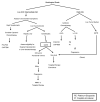Management of Appendix Neuroendocrine Neoplasms: Insights on the Current Guidelines
- PMID: 36612291
- PMCID: PMC9818268
- DOI: 10.3390/cancers15010295
Management of Appendix Neuroendocrine Neoplasms: Insights on the Current Guidelines
Abstract
Appendiceal neuroendocrine neoplasms (ANENs) usually present as incidental findings at the time of appendectomy for acute appendicitis. They are rare, accounting for only 0.5-1% of intestinal neoplasms; they are found in 0.3-0.9% of all appendectomy specimens. They are usually sporadic tumors. There are several histological types including well-differentiated neuroendocrine tumors (NETs), poorly differentiated neuroendocrine carcinomas (NECs), and mixed neuroendocrine-non-neuroendocrine neoplasms (MiNENs). Histologic differentiation and the grade of well-differentiated NETs correlate with clinical behavior and prognosis. Management varies based on differentiation, aggressiveness, and metastatic potential. There is debate about the optimal surgical management for localized appendiceal NETs that are impacted by many factors including the tumor size, the extent of mesoappendiceal spread, lymphovascular invasion and perineural involvement. In addition, the data to guide therapy in metastatic disease are limited due to the paucity of these tumors. Here, we review the current advances in the management of ANENs within the context of a multidisciplinary approach to these tumors.
Keywords: appendix; management; neoplasms; neuroendocrine.
Conflict of interest statement
None of the authors has a conflict of interest to declare.
Figures





References
-
- Van De Moortele M., De Hertogh G., Sagaert X., Van Cutsem E. Appendiceal cancer: A review of the literature. Acta Gastroenterol. Belg. 2020;83:441–448. - PubMed
Publication types
LinkOut - more resources
Full Text Sources

